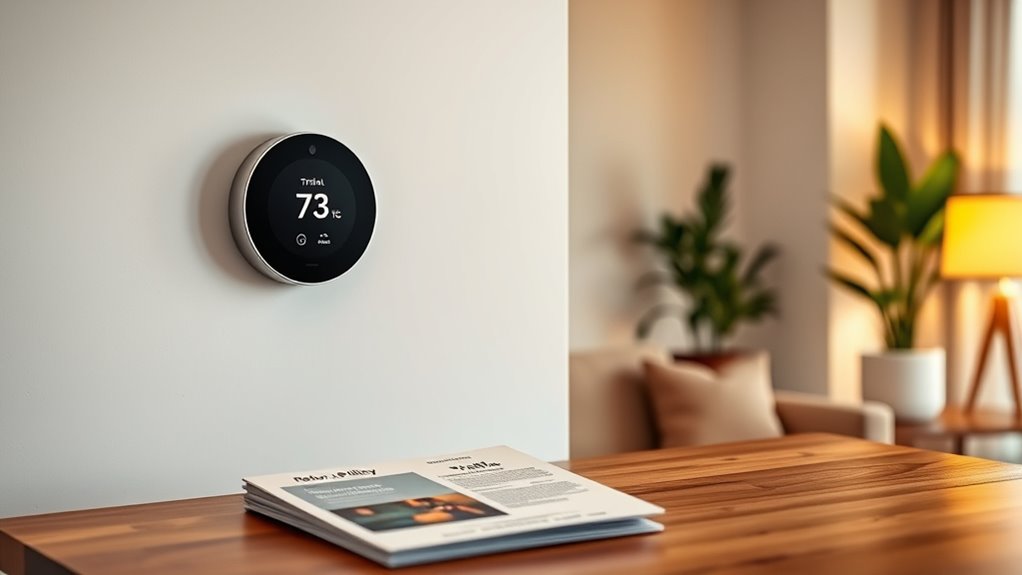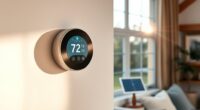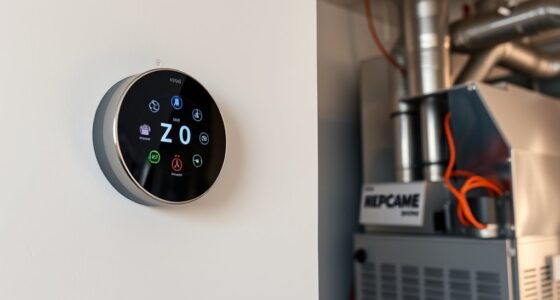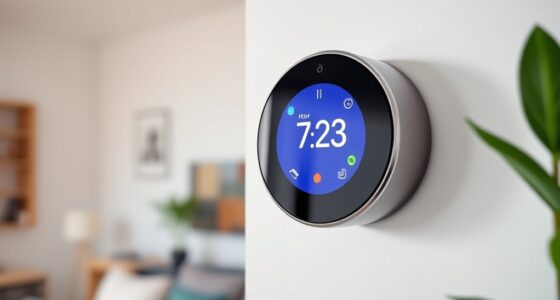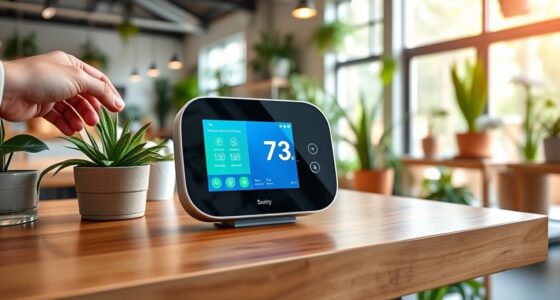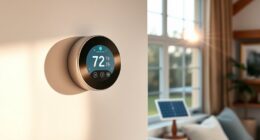When returning a smart thermostat, check the retailer’s or manufacturer’s specific policies, which often require the device to be in original packaging and unused. Many stores offer trial periods, usually 14 to 30 days, allowing you to test the device at home. Warranty coverage is common for 1-2 years but can be voided if installation or usage isn’t proper. Knowing these details helps you avoid surprises—continue exploring to understand what your options are and how to proceed smoothly.
Key Takeaways
- Return policies vary by retailer; check specific deadlines and conditions before purchasing.
- Most smart thermostats must be unused, in original packaging, and uninstalled for returns.
- Trial periods typically last 14-30 days, allowing testing; returns are accepted if devices remain unused.
- Warranty coverage generally lasts 1-2 years and covers defects; improper installation may void warranty.
- Understanding warranty terms and return conditions helps avoid fees and ensures a smooth return process.
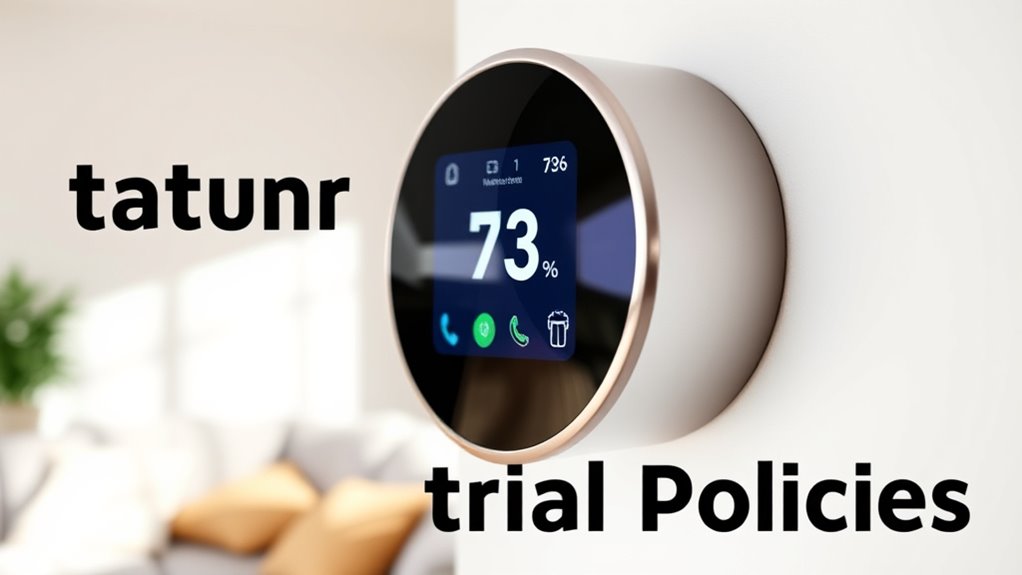
Ever wondered what you need to know before returning a smart thermostat? It’s a smart move to familiarize yourself with the return policies, especially since these devices can sometimes be tricky to install or might not meet your expectations. One of the first things to consider is understanding the installation requirements. Many smart thermostats need specific wiring, compatible HVAC systems, or a stable Wi-Fi connection to function properly. If these requirements aren’t met, the device might not work as intended, and attempting to return it could be complicated if you’ve already installed it. Some retailers or manufacturers specify that the product must be in its original, uninstalled condition for a return to be accepted, so you should check the fine print before opening the box. Knowing the installation requirements upfront helps you avoid unnecessary hassle or potential fees if you need to send the device back.
Warranty coverage is another critical aspect to consider. Most smart thermostats come with a warranty that covers manufacturing defects or malfunctions within a certain period, often one or two years. If you encounter issues during the warranty period, you might be able to get a replacement or repair instead of returning the device outright. However, it’s essential to understand what the warranty covers and what it excludes. For example, damage caused by improper installation, misuse, or physical harm might void the warranty, so following the manufacturer’s installation instructions is crucial. If your thermostat develops problems that are covered under warranty, you could save time and money by opting for repair or replacement rather than returning the unit. Conversely, if the device is outside its warranty period or the issues aren’t covered, returning it might be the better option.
Additionally, some retailers offer trial periods for smart thermostats, giving you the chance to test the device in your home before committing fully. During these trial periods, you can evaluate its performance, compatibility, and ease of use. If it doesn’t meet your expectations, most stores allow you to return the device within a specified window—often 14 to 30 days—without penalties. Just remember to keep the product in good condition, include all original packaging, and adhere to the return instructions to ensure a smooth process.
Being aware of smart device return policies and their specific conditions can help prevent unexpected issues and ensure a hassle-free return if needed. Understanding these key aspects—installation requirements, warranty coverage, and trial periods—makes returning a smart thermostat less stressful. Being informed helps you make smarter decisions and guarantees you’re not caught off guard by return policies or hidden conditions. Whether you’re returning due to technical issues, incompatibility, or simply changing your mind, knowing what to expect will help you navigate the process confidently.
Frequently Asked Questions
Can I Return a Smart Thermostat After Installation?
Yes, you can typically return a smart thermostat after installation if you’re unsatisfied, but it depends on the retailer’s policies. Check for specific return windows and conditions, especially regarding installation concerns like damage or incompatibility. Be aware that warranty coverage may not apply if the device is altered or damaged after installation. Always review the return policy before purchasing to ensure you’ll be able to return it if needed.
Do Return Policies Vary by Retailer?
Yes, return policies do vary by retailer. You should always check each retailer’s policies because their return window and conditions can differ. Some may offer a longer return window or allow returns after installation, while others might have stricter rules. Always review retailer policies before purchasing or installing a smart thermostat to guarantee you understand your options if you decide to return it.
Are There Restocking Fees for Smart Thermostats?
Think of return policies like a garden maze—sometimes clear, sometimes winding. Restocking fees for smart thermostats vary by retailer, and some might charge them, especially if the item’s opened or used. Return restrictions also differ, so check each retailer’s policy before you buy. You could end up paying a restocking fee or facing limited return options if you don’t review the terms first. Always read the fine print to avoid surprises.
How Long Do Trial Periods Typically Last?
Trial periods for smart thermostats typically last 30 to 60 days, giving you enough time to evaluate their features and performance. During this trial, your installation timeline is usually quick, often within a few days, and warranty coverage remains active, protecting you from defects. If you decide to return the thermostat, check the company’s policy to avoid extra fees, ensuring a smooth experience during your trial period.
Can I Exchange a Thermostat During the Trial?
Yes, you can usually exchange a thermostat during the trial if you experience installation challenges or compatibility concerns. Most companies allow returns or exchanges within the trial period, so if your current device doesn’t work well with your system or if installation proves difficult, reach out to customer support promptly. Keep the receipt and original packaging handy, and act swiftly to ensure a smooth exchange process.
Conclusion
Just like Icarus learned when he flew too close to the sun, rushing into a smart thermostat purchase without understanding the return policy can lead to disappointment. By knowing the trial options and return terms, you’re steering clear of potential pitfalls and making a confident choice. Remember, a smart decision today ensures comfort tomorrow—so take the time to read those policies and avoid flying too close to the sun.
